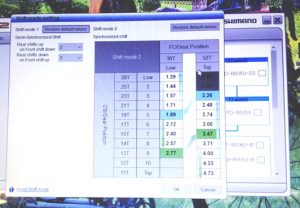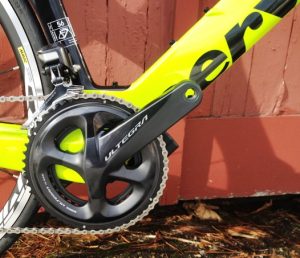Shimano Di2 Synchro Shift for Triathletes
Shimano’s Di2 electronic shifting has long been an excellent shifting system on road bikes, but is arguably even better on tri bikes. Eliminating the numerous twists and kinks that are inherent in aero bike cabling, while offering push button ease, offers big benefits when it comes to staying aero, reducing maintenance, maintaining cadence and improving shift quality. Shimano’s new Dura Ace 9150 and Ultegra 8050 Di2 shifting system (designated 9160 and 8060 with aero shifters) does all that previous generation Di2 does. However, it has some new tricks too; tricks in the form of Shimano Di2 Synchro Shift, which makes shifting on a tri bike easier than ever. As easy as just having one button to shift into a higher gear and another to shift into a lower and no others (the previous generation 6870 had separate buttons for the front and rear derailleur).
How’s the single button system work? Let me explain, via Cervelo’s always fast 2018 P3 with Ultegra 8060 Di2 Synchro Shift.
SHIMANO Di2 SYNCHRO SHIFT IN A NUTSHELL
The latest Shimano Dura Ace 9150, and now Ultegra 8050, Di2 systems includes Shimano Synchro Shift. Not including the “off” setting (which has functionality on the road versions, but not the TT versions), there are two varieties of Shimano Di2 Synchro Shift available: “Semi” and “Full”.
Shimano Di2 Synchro Shift Semi for Road Bikes
The “Semi” version of Shimano Di2 Synchro Shift works with Shimano’s STI road levers for drop bars and keys off the crankset and front derailleur. The best way to explain how “semi synchro” works is through an example. Say you are climbing in your large front chainring and shifting into easier gears with the rear derailleur as you go. You then decide to shift to the small chainring. In order to keep the gearing progression even, you would normally shift the rear derailleur to a smaller cog at the same time as you shift the front – usually shifting the rear two cogs smaller as you shift the front from big to small ring. With Semi Synchro Shift engaged, the rear derailleur takes care of the adjustment itself. When you shift the front chainring, the rear automatically shifts with it to keep your cadence and gear progression as linear as possible. While Shimano’s default number of rear gears it shifts is two, you can program how many cogs it will shift in the rear, from 1 to 3. The same applies if you are in the small chainring and shifting to the larger front chainring, but in reverse. The rear derailleur will automatically shift 1-3 cogs easier when you shift from the

small to the big chainring, approximating the same cadence you had before you shifted.
Shimano Di2 Synchro Shift Full for Road or TT Bikes
“Full” Di2 Synchro Shift, as found on the TT shifters, is a bit more complicated. Full Synchro keys off the rear derailleur. Say you are in the large chainring in the front, while shifting into progressively lower and lower gears in the back, such as on a climb. When you reach a preprogrammed point on the rear cassette with your rear shifting, the front derailleur automatically engages and shifts the chain to the small front chainring. At the same time, the rear derailleur will shift the chain two cogs harder, or some other number that you can program, to keep the gearing progression as linear as possible. The reverse happens when shifting the other direction, into a harder gear. In both cases, you can specify where in the cogset front shifts will take place and you can specify how many cogs it will shift in the rear simultaneously.
USING ULTEGRA 8060 Di2 SYNCHRO SHIFT ON TRI BIKES
 The new “single button” aero shifters from Shimano, the ones on almost all ’18 production tri bikes, more or less require that you use the “Full” Synchro mode of Synchro Shift. The shifting is divided between left hand and right hand shift buttons and directly control the rear derailleur only. The left hand buttons, whether on the brake lever or on the aero extension, shift the rear derailleur inward, shifting to larger cogs/easier gears. The right hand buttons shift the derailleur outward, to smaller cogs/harder gears. Shimano allows you to reprogram the shift buttons to do the reverse if you want, so whatever your brain finds most intuitive is possible. The front derailleur automatically takes care of itself, shifting between large and small chainrings as programmed. As a result, all the rider needs to think about is whether they want a harder or easier gear; the Shimano Di2 Synchro Shift system takes care of the rest.
The new “single button” aero shifters from Shimano, the ones on almost all ’18 production tri bikes, more or less require that you use the “Full” Synchro mode of Synchro Shift. The shifting is divided between left hand and right hand shift buttons and directly control the rear derailleur only. The left hand buttons, whether on the brake lever or on the aero extension, shift the rear derailleur inward, shifting to larger cogs/easier gears. The right hand buttons shift the derailleur outward, to smaller cogs/harder gears. Shimano allows you to reprogram the shift buttons to do the reverse if you want, so whatever your brain finds most intuitive is possible. The front derailleur automatically takes care of itself, shifting between large and small chainrings as programmed. As a result, all the rider needs to think about is whether they want a harder or easier gear; the Shimano Di2 Synchro Shift system takes care of the rest.
Derailleur Set-Up
With Shimano Synchro Shift, finite derailleur adjustment becomes more crucial then ever. If you do not have independent control over the front derailleur, you want to be sure that it works perfectly. The 8050 Di2 front derailleur does just that, particularly in conjunction with the Shimano 8000 crank and chainrings. The front derailleur cage is very stiff, as are the chainrings. So, shifting is very firm, with no slop or rattling around. It is also imperative that the front derailleur be positioned correctly and that the derailleur high limit screw is set correctly, so you don’t throw the chain when it shifts to the big chainring. The derailleur operation must also be programmed correctly, so that it repositions correctly while you shift through the rear cogs, and so that you do not throw the chain off to the inside when it shifts from the outer chainring to the inner.
SHIMANO Di2 SYNCHRO SHIFT. WHY NOT?
While many will find that Shimano Di2 Synchro Shift makes shifting more intuitive and easier, some may balk at letting the system do the “thinking”. For these folks, 6870 Di2 brake levers and  aero bar-end shifters with two buttons on each are still available and will work with the rest of the 8050 components. This being said, I would try Shimano Di2 Synchro Shift before discarding it. Most people insist on a car with an automatic transmission and Synchro Shift is something similar on your bike? Triathletes have enough to occupy their attention than proper shifting technique. Not worrying about what gear combination you are in, losing as much as five watts of power by cross-chaining, and not having to look down to see what gear you are in has a lot of advantages.
aero bar-end shifters with two buttons on each are still available and will work with the rest of the 8050 components. This being said, I would try Shimano Di2 Synchro Shift before discarding it. Most people insist on a car with an automatic transmission and Synchro Shift is something similar on your bike? Triathletes have enough to occupy their attention than proper shifting technique. Not worrying about what gear combination you are in, losing as much as five watts of power by cross-chaining, and not having to look down to see what gear you are in has a lot of advantages.
To learn more about Shimano’s Di2 Synchro Shift found in the latest Ultegra and Dura Ace groups, or the 2018 Cervelo P3 (with out without Di2), contact us today.
